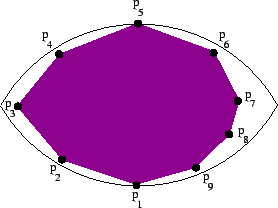 |
They can be constructed.
(It's no use defining a family counterexamples
that are impossible to construct; otherwise
they can't be counterexamples!)
The simplest such polygon consists of
four points
(p1, p2, p3, p4) with
p2 near one intersection
and p4 near the other interesection
of the circles centered at p1 and p3
each of radius
d (p1, p3).
See Figure 6.
Thus, p1 and p3 are our pi and pj
and
p2 and p4 alone achieve the diameter
which is slightly less than
![]() d (p1, p3).
d (p1, p3).
Because of the way the polygon is constructed, the point furthest from pi is pj, and vice versa. Recall that all points other than pi and pj lie inside the circles centered at pi and pj of radius d (pi, pj). As a result, if the algorithm begins at A = pi then it will find B = pj at a maximum distance from A = pi. Then, when it searches for a point at a maximum distance from B = pj it finds pi so the algorithm incorrectly terminates with A = pi and B = pj as two points achieving the diameter.
See if you can construct one of the polygons described above
and then watch how the Snyder and Tang algorithm handles it.